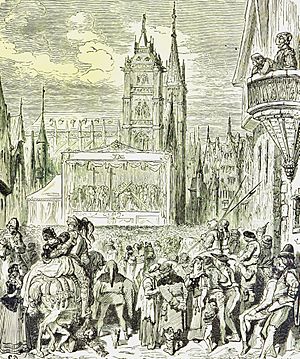Mystery play facts for kids
Mystery plays and Miracle plays were super popular types of theater way back in the Middle Ages in Europe. Imagine going to a play that taught you stories from the Bible or about amazing saints! That's exactly what these plays did.
Contents
What Were Medieval Plays?
During the Middle Ages, most people couldn't read. So, how did they learn important stories, especially from the Bible? Plays were a fantastic way! These early forms of theater helped people understand religious stories and lessons in a fun and memorable way. They were a big part of community life.
Telling Bible Stories: Mystery Plays
Mystery plays focused on stories directly from the Christian Bible. They often showed famous events like the creation of the world, Noah's Ark, or the life of Jesus. These plays were called "mystery" not because they were puzzling, but because the word "mystery" also meant a religious truth or a craft practiced by guilds.
Many towns had groups of workers, called guilds, who would put on these plays. For example, the bakers' guild might perform the Last Supper, or the shipbuilders might perform Noah's Ark. Each guild took responsibility for a specific part of the story.
Amazing Lives: Miracle Plays
Miracle plays were a bit different. Instead of Bible stories, they told tales about the lives of saints. Saints were people believed to have lived very holy lives and performed miracles. These plays often showed how saints faced challenges, helped others, and sometimes even performed amazing feats.
A popular saint featured in these plays was Saint Nicholas, who is often linked to the modern-day Santa Claus. These plays aimed to inspire people and show them how faith could lead to good deeds and even miracles.
Where Were They Performed?
At first, these plays were performed inside churches. They were part of religious services, helping to explain the lessons of the day. But as they grew more popular and complex, they moved outside.
Soon, plays were performed in town squares, marketplaces, or even on special stages called pageant wagons. These wagons were like mobile stages that could be moved from one part of the town to another. This way, many people could watch the plays as the wagons traveled through the streets.
Who Were the Actors?
Most of the actors in these medieval plays were ordinary people from the town, not professional actors. They were often members of the guilds that sponsored the plays. Men played all the roles, even the female characters.
The costumes were often simple, using everyday clothes with a few special additions to show who a character was. For example, an angel might have wings, or a king might wear a crown. The goal was to make the stories clear and easy to follow for everyone watching.
Why Were These Plays Important?
Mystery and Miracle plays were more than just entertainment. They were a vital way to teach people about their religion and history. They helped communities come together and share common stories. They also showed how theater could be a powerful tool for education and storytelling, laying some of the groundwork for the plays we enjoy today.
Images for kids
-
Depiction of a performance of the Mystery Play of Saint Clement in Metz during the Middle Ages.
-
Actors portraying Adam and Eve are expelled from paradise in a performance by the Players of St Peter
See also
 In Spanish: Misterio (teatro) para niños
In Spanish: Misterio (teatro) para niños




